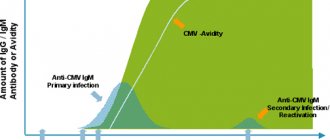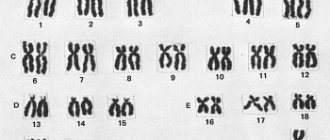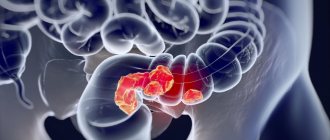Home > Encyclopedia of Oncology > What does a blood test for tumor markers show?
To find out what a blood test for tumor markers shows, you need to properly prepare and take it in the first half of the day.
This can be done in a laboratory either at a clinic or in a private independent medical institution with a good reputation. Please note that the price of a blood test for tumor markers depends on which marker needs to be checked, how many such tests are prescribed and the reliability of the selected laboratory. Consult an Israeli specialist
What do the results of tumor marker analysis say?
Tumor markers are specific protein compounds that are produced by pathological formations in the body or healthy cells in order to protect the body from harmful processes. Depending on this, there are markers that are constantly present in the body in minimal quantities, and there are those that appear only in the presence of a tumor. Thus, it is necessary to know what a blood test for tumor markers shows for risk groups and those who have once encountered cancer.
This test is not prescribed if there are no symptoms or a genetic predisposition to cancer. Only in exceptional cases can it be indicated for persons over 50 years of age who are employed in hazardous industries.
Testing results in this case may show the presence of a pathological lump at an early stage (depending on the tumor marker 3-5 months before the onset of the first symptoms of cancer), an inflammatory disease, a benign neoplasm, and the risk of pathology in the fetus. All this speaks to the importance of analysis for tumor markers in the modern diagnosis of tumors and pathologies of embryonic development.
What are tumor markers
Tumor markers (TM) are specific biological substances that are produced by tumor cells during growth and vital activity or by the body in response to tumor development.
Moreover, they can be qualitatively and quantitatively determined in biological fluids of the body (blood, urine, etc.). Nowadays, various types of tumor markers are used for the diagnosis, treatment and monitoring of patients with tumor diseases, including the detection of metastases and relapses.
OM are divided into:
- tumor-specific - characteristic only of cancer cells, not normally produced,
- associated with a tumor - are also present in normal cells, but with the development of a tumor their level increases sharply.
About 200 similar substances with greater or lesser organ- and tumor-specificity are already known. For example, CA 72-4 is highly specific for gastric cancer, and PSA is highly specific for prostate cancer. However, more often OM does not have such specificity, so it is recommended to test for several tumor markers at once.
Based on their biological functions, the following OMs are distinguished:
- Oncofetal antigens are substances characteristic of embryonic tissues that appear on the surface of cells during their differentiation. In adults, their level is very low, increases only with the growth of the tumor and depends on its size. Their determination is important for diagnosis and prognosis of the course of the disease, as well as for monitoring the effectiveness of therapy. Examples: carcinoembryonic antigen (CEA), alpha-fetoprotein (AFP), human chorionic gonadotropin (hCG), pregnancy beta protein, CA 125, CA 15-3, CA 19-9 and others.
- Enzymes are also characteristic of embryonic tissues. Some of them continue to perform certain functions in adults (for example, lactate dehydrogenase), their determination helps to establish the location of the primary tumor. The role of other enzymes in the formed organism is unknown (tissue polypeptide antigen, neuron-specific enolase), their level increases in poorly differentiated tumors.
- Hormones are produced by cells of the endocrine glands in which tumors develop, or by other organs, which does not occur normally. Most often used to monitor treatment.
- Receptors - an increase in their number is characteristic of hormonally active tumors. These markers are tissue markers and are not detected in the blood (only in biopsy material).
- Other compounds do not belong to any of the previous groups; they are normally present in the body, but with the development of cancer, their level increases sharply (ferritin, immunoglobulins, etc.).
When to donate blood for markers and how to prepare
Let us immediately note that what a blood test for tumor markers shows is not a diagnosis. This is only the first step, which can carry up to 95% of what is happening in the body. Therefore, checking the oncoprotein norm is always accompanied by other examination methods, in particular, magnetic resonance and computed tomography, ultrasound, and radiography.
The main indications for analysis are:
| Diagnosis of early detection of cancerous compaction. |
| Checking for the presence of metastases in the absence of any symptoms. |
| Drawing up the most suitable and effective treatment program for cancer, selecting medications and their dosages. |
| Monitoring and evaluating the effectiveness of the chosen treatment program and the effectiveness of the drugs used. |
Testing the normal level of tumor markers is prescribed for risk groups and people over 50 years of age, since the production of these substances increases with age.
Please note that a blood test for tumor markers in women and men is taken only for each type separately, as prescribed by the doctor. Depending on the suspected location of the tumor, testing only one marker may be sufficient to identify it. But more often than not, the complete picture is provided by the group that best fits together.
Preparation in most cases does not require special actions, and it is almost similar to the requirements for a blood biochemistry test:
| Refusal to eat 4-12 hours before the procedure. You should also exclude coffee, tea and juices. Only non-carbonated water is acceptable, including on the day of blood collection. |
| Stop using medications in consultation with your doctor. If this is not possible, you should definitely notify the laboratory assistant about this. |
| Avoid alcohol and smoking 12 hours before the start (this also applies to hookah, smoking various aromatic tobaccos and electronic cigarettes). |
| Try not to visit a massage therapist or undergo diagnostic manipulations several hours before testing. |
| Reduce physical activity. Enough leisurely walks. |
It is also necessary, if possible, to prevent stressful situations and not to be nervous. Remember that compliance with these requirements will allow you to obtain high-quality and reliable results.
Women need to plan the analysis based on the period of the menstrual cycle. An appropriate specialist will help you choose the right day when your hormonal levels are optimal.
In what cases is it indicated to conduct a blood test for tumor markers?
- Diagnosis of cancer by blood test . Such studies can be prescribed for preventive purposes to assess the risk of developing the disease (if there is evidence of the hereditary nature of a particular pathology) and to detect cancer at an early (pre-symptomatic) stage. For example, identifying a mutation in the APC gene is a fairly accurate indicator of the presence of hereditary adenomatous polyposis and colon cancer.
- Determining the prognosis of an already identified cancer (prognostic tests). The levels of tumor markers and their changes give reason to assume how the tumor will behave, how quickly it will develop and how aggressive it will be. These tests include the PSA test, which helps predict the malignant potential of prostate cancer.
- Detection of tumor relapses or metastases. An increase in the level of OM in the blood of a person who has undergone treatment for a tumor disease may indicate the likelihood of re-development of the tumor at the site of the removed one or distant metastases, when the cells of the primary tumor spread throughout the body.
- Assessment of tumor sensitivity to a specific therapy method and treatment results (predictive and pharmacogenetic tests). Helps to adjust the treatment regimen and choose the optimal method. Can determine the level of toxicity of chemotherapy and the expected response to treatment with cytostatics or targeted drugs.
- Management of cancer patients - identification of remnants of tumor tissue, metastases, monitoring the course of the disease and clinical observation.
Technique for testing blood for oncoproteins
The point of testing is that you need to be tested for tumor markers in a specialized laboratory.
The best time for this procedure is between 8 and 12 am. Before starting, the patient is seated on the couch (in some cases it is necessary to take a supine position), then blood is taken from a vein in the traditional way using a syringe and the material is transferred to a test tube with a cap.
The resulting blood is processed in special equipment, where the serum is separated from the plasma. The resulting serum is the sample into which antibodies are injected and the interaction is observed. The resulting reaction is the result of a blood test for tumor markers, and what it shows is entered into the patient’s card.
What other tumor markers are used to diagnose cancer?
For dynamic monitoring of patients during treatment, OM is determined, which can indicate the effectiveness of the treatment, confirm the radicality of tumor removal or the occurrence of a second tumor.
To confirm the effectiveness of therapy, predictive and pharmacogenetic tests are required. Thus, it is mandatory to determine the tumor markers KRAS and EGFR in tumor tissue. This analysis will help you choose a drug for chemotherapy. In the presence of a mutant KRAS gene, the use of monoclonal antibodies for targeted therapy of colorectal cancer is absolutely ineffective. On the other hand, a positive test result for an EGFR mutation may be the basis for the prescription of anti-EGFR drugs (for non-small cell lung cancer - NSCLC).
To predict and diagnose tumor aggressiveness in breast cancer, HER2 is determined. If the test is positive, the tumor cells will be most sensitive to the drug Herceptin.
The EML4-ALK fusion test in NSCLC helps determine the sensitivity of cancer cells to crizotinib. This has increased survival and freedom from relapse in patients with this aggressive cancer.
In melanoma, it is important to analyze mutations in the BRAF V600E gene, the positive result of which indicates the effectiveness of vemurafenib in such patients. This test also launched a series of developments of targeted drugs for the treatment of resistant forms of the disease.
Norms and explanation of the 10 most informative markers
In total, more than 200 different tumor markers are known in medicine. But only about 20 are considered the most informative.
| PSA | demonstrates prostate hardening. The normal amount should not exceed 4 ng/ml. An increase in level to 10 ng/ml indicates a risk of developing cancer, and exceeding 10 ng/ml is considered critical. |
| CEA (carcinoembryonic antigen) | The norm is no more than 5 ng/ml, an increase to 8 mg/ml is considered a risk, and if the level exceeds 8 mg/ml, it means a malignant lump in the rectum/colon, as well as a number of other organs. |
| CA125 (ovarian tumor marker) | The norm is no more than 30 IU/ml. An increase to 40 IU/ml indicates a high risk of developing a harmful neoplasm. An increase of more than 40 IU/ml almost always means ovarian cancer. |
| CA19-9 (pancreatic protein) | A normal level is considered to be up to 30 IU/ml; a range of 30-40 IU/ml indicates the presence of a lump; above 40 IU/ml indicates the development of a cancerous tumor. |
| CA15-3 (breast cancer marker) | Its normal level is considered to be 38 IU/ml maximum. Any increase is a serious reason to undergo additional examination. |
| CA242 (tumor marker for pancreatic, rectal and colon cancer) | As a result of the analysis for tumor markers, it is deciphered by the following indicators: % normal - no more than 30 IU/ml. Everything above indicates the presence of a neoplasm, both benign and malignant. |
| UBC (bladder cancer marker) | Its normal amount is considered to be 15 ng/ml. |
| HCG (hormone) | Its increase is considered normal only during pregnancy. In the body of girls and men, the norm is 2.5 – 5 IU/ml maximum. If this indicator in a non-pregnant body rises to more than 10 IU/ml, the development of chorionic carcinoma of the placenta or ovary, trophoblastic compaction, or testicular tumor should be assumed. |
| AFP (alpha protein) | Its norm is considered to be 15 IU/ml only during pregnancy. If it is detected in a non-pregnant woman, there is a suspicion, mainly of liver cancer. |
| B2-MG (beta-2 microglobulin) | Its norm should be in the range of 670 – 2140 ng/ml. An increase in the extreme figure indicates the possible development of such dangerous diseases as lymphoma, multiple myeloma, B-cell lymphocytic leukemia, which are oncological in nature. |
Thus, if you have indications or a predisposition to tumors, you need to urgently take a blood test for tumor markers in vitro at a price that in any case will be lower than the likely treatment.
What tumor markers are determined in screening programs?
Oncotests can be prescribed to patients individually as part of a general examination plan. But there are already a number of tumor markers, the determination of which is included in mass (screening) programs. These are studies that are easy and inexpensive to conduct as part of annual preventive examinations for both men and women. In this way, risk groups that need further monitoring can be identified.
Examples of such studies:
- PSA (PSA) – prostate-specific antigen – a marker of prostate cancer.
- CA 125 - detects ovarian cancer.
- BRCA 1,2 is a gene mutation characteristic of hereditary ovarian and breast cancer.
International specialized organizations include new tests in their recommendations every year. Among them are the determination of some serological OMs (for example, CA-15-3, CA-27, CEA), histochemical (Her2, Ki67), and molecular genetic ones, such as Mammaprint.
Why are tumor markers needed?
First of all, tumor markers or tumor cell markers are used for timely detection or diagnosis of cancer cells. It is also used when assessing the effectiveness of treatment and prescribing more effective anticancer therapy, and accordingly reflects the possible prognosis or probable outcome of malignant oncology.
The diagnosis of malignant oncological disease is not made only based on the results of analysis of tumor markers. For a reliable diagnosis, it is necessary to take into account many factors and data from a comprehensive examination prescribed by an oncologist.
What studies can show oncology?
1. Complete blood count - shows the total number of red blood cells, platelets, leukocytes and other blood cells. When the indicators deviate from the norm, this may indicate the presence of a malignant neoplasm.
2. Biochemistry. With its help you can find out the chemical composition of the blood. This analysis allows us to identify where a malignant tumor develops in the human body.
3. Tumor markers. This is perhaps the most accurate test for detecting cancer. As soon as malignant cells appear in the body and undergo mutation, they release tumor markers into the blood. Since the body does not accept such protein, it immediately begins to fight it. Each tumor has its own tumor markers, with the help of which the doctor immediately knows which organ was affected.
Our clinics in St. Petersburg
Structural subdivision of Polikarpov Alley Polikarpov 6k2 Primorsky district
- Pionerskaya
- Specific
- Commandant's
Structural subdivision of Zhukov Marshal Zhukov Ave. 28k2 Kirovsky district
- Avtovo
- Avenue of Veterans
- Leninsky Prospekt
Structural subdivision Devyatkino Okhtinskaya alley 18 Vsevolozhsk district
- Devyatkino
- Civil Prospect
- Academic
For detailed information and to make an appointment, you can call +7 (812) 640-55-25
Make an appointment
A benign or malignant neoplasm secretes a special cancer antigen. In this regard, when different tumors arise in the body, their own tumor markers appear. Tumor marker studies are also carried out in case of diagnosis of the disease and its treatment. It will allow doctors to choose subsequent tactics and, if necessary, prescribe additional drugs.
Tumor markers
HomeFor patientsAbout cancerDiagnosticsTumor markers
Tumor markers (tumor markers) are special substances that in many (but not all!) cases are produced by tumor cells during their life. In addition, they can be released by normal cells of the body in response to the presence of tumor cells. Tumor markers can be found in blood, urine, stool, tumor tissue and other media (fluids) of the body. At the moment, a large number of tumor markers have been discovered and introduced into clinical practice. Some of them can increase only in certain types of malignant neoplasms, others - in many types of tumors.
What are tumor markers used for?
In oncology, determination of the concentration of tumor markers is used for the following purposes:
- During the diagnostic search, in cases where the patient is suspected of having a malignant tumor. They are also used in the process of searching for the primary tumor in patients with metastatic organ damage - for example, an increase in the concentration of tumor markers can give a “clue” about the nature of a randomly detected mass formation in any organ, or suggest the localization of the primary tumor to facilitate its search;
- Assessing the effectiveness of the treatment - since in many cases the concentration of tumor markers is closely related to the available volume of tumor mass (the number of living tumor cells), a decrease in their concentration during treatment may be evidence of the effectiveness of the treatment. The opposite is also true - an increase in the concentration of tumor markers during treatment may be a sign of progression of the tumor process.
- In some cases, determination of the concentration of tumor markers in the blood plasma is used in the process of monitoring the patient’s condition after completion of the treatment phase for early detection of tumor relapse. This can help start treatment in a timely manner;
- For individual tumors, the concentration of tumor markers is used to determine the prognosis of the disease and select treatment tactics.
It is necessary to highlight some disadvantages of this diagnostic test. Tumor markers can be produced in small quantities by healthy cells outside the presence of malignant cells. Fluctuations in their concentration within normal values are not evidence of the presence of any oncological pathology. An increase in the concentration of tumor markers and its exit beyond normal values may be due to the presence of non-tumor diseases. For example, β-hCG can increase during pregnancy, and AFP can increase in non-tumor liver diseases, such as viral hepatitis.
When using tumor markers as an indicator of treatment effectiveness, one should be aware of the possibility of a so-called “flare” - an increase in their concentration shortly after the administration of drugs, including a sharp increase in the concentration of tumor markers. This is due to the death of tumor cells and the massive release of tumor markers into the blood from dead cells and is not a sign of treatment failure.
How is the concentration of tumor markers determined?
Most often, the patient's venous blood is used to determine their concentration. In almost all cases, this procedure is performed before starting treatment and, if an increase is detected, the attending physician decides whether to use this method in the future. If the concentration of tumor markers is used to assess the effectiveness of treatment, then blood samples for this analysis are performed regularly, for example, every 2 courses of treatment.
What tumor markers are currently used?
At the present stage of development of medicine, many substances are known that are produced by tumor cells. The table below provides information on the most commonly used tumor markers.
| Tumor marker | Disease | What is it used for? |
| Alphafetoprotein (AFP) | Liver cancer; Germ cell tumors of the testis (testicular) or ovarian cancer | During the diagnostic process, the concentration of AFP may increase in these diseases; evaluation of the effectiveness of liver cancer treatment; determining the stage and prognosis in patients with germ cell tumors, assessing the effectiveness of treatment. |
| Beta human chorionic gonadotropin (β-hCG) | Chorionic carcinoma; Germ cell tumors of the testis (testicular) or ovarian cancer | determining the stage and prognosis of the disease, assessing the effectiveness of treatment. In addition to blood, urine can be used for analysis |
| Beta-2-microglobulin (β2M) | Multiple myeloma; Chronic lymphocytic leukemia | Determining prognosis and assessing the effectiveness of treatment. In addition to blood, urine and cerebrospinal fluid can be used for analysis |
| Prostate-specific antigen (PSA) | Prostate cancer | Diagnosis of the disease, assessment of treatment effectiveness, early detection of relapses |
| CA19-9 | Malignant tumors of the gastrointestinal tract: Cancer of the pancreas, gall bladder and biliary tract, stomach cancer, colon cancer | Evaluation of treatment effectiveness |
| SA-125 | Ovarian cancer, fallopian tube cancer, primary peritoneal cancer | Diagnostics, assessment of treatment effectiveness, early diagnosis of relapses |
| HE-4 | Ovarian cancer, fallopian tube cancer, primary peritoneal cancer | Diagnostics, assessment of treatment effectiveness, early diagnosis of relapses |
| Calcitonin | Medullary thyroid cancer | Diagnosis of the disease, assessment of treatment effectiveness, early detection of relapses |
| Carcinoembryonic antigen (CEA) | Colon cancer and some other tumors | Assessing the effectiveness of treatment, diagnosing relapses |
| LDH | Germ cell tumors of the testis (testicular cancer) and ovaries, lymphomas, leukemia, melanoma, neuroblastoma | Assessment of the stage, prognosis of the disease and assessment of the effectiveness of treatment |
| Chromogranin A (ChgA) | Neuroendocrine tumors | Diagnosis of the disease, assessment of treatment effectiveness, early detection of relapses |
| Neuron-specific enolase (NSE) | Small cell lung cancer; Neuroblastoma | Diagnosis of the disease, assessment of treatment effectiveness |
| Cytokeratin 21-1 | Lung cancer | Relapse detection |
| Fibrin/Fibrinogen | Bladder cancer | Determination of concentration in urine is used to detect relapses and evaluate the effectiveness of treatment |
| Immunoglobulins | Multiple myeloma; Waldenström's macroglobulinemia | Diagnosis of the disease, assessment of treatment effectiveness, detection of relapses |
| SA15-3, SA27.29 | Mammary cancer | Currently rarely used, in some cases they are used to evaluate the effectiveness of treatment |
Is it possible to donate blood to “check for cancer”?
The idea of diagnosing and early detection of cancer using a blood test looks extremely attractive - the procedure for testing blood (or other body media) for tumor markers is simple to perform, cheap, widely available and associated with minimal risks of intervention. In addition, it takes little time, which is convenient for both the doctor and the patient. After it was shown that the volume of the tumor mass correlates with the concentration of tumor markers, many studies have been devoted to this problem. Their goal was to find out whether tumor markers are suitable for screening for cancer.
Any diagnostic test is characterized by two characteristics: sensitivity and specificity.
Sensitivity
– the ability of a diagnostic test to identify people who have a disease and not “miss” sick people. A highly sensitive test will detect most people who have the disease, but there may also be false-positive results, which means the test is positive when in fact there is no disease. When using a highly sensitive but low specific test (see below), a positive test result will not mean the presence of the disease, but the need for a “targeted” examination in order to exclude it. On the other hand, if the test is not sensitive enough, it may not detect the disease in a person (false negative) who already has cancer, which can lead to a late diagnosis.
Specificity
– the likelihood that the test will not produce a false positive result – that a patient with a positive test result actually has the disease. If the test is not specific enough, it may give a positive result in the absence of a tumor, which can result in a healthy person being subjected to unnecessary tests.
A good screening test suitable for early detection of tumors should have high sensitivity and specificity. Unfortunately, tumor markers do not meet such high requirements. In the early stages of the tumor process, their concentration, as a rule, remains low and the determination of tumor markers leads to false negative results. An increase in the level of tumor markers can be caused by non-tumor causes, which also leads to additional difficulties in diagnosis.
However, tumor markers are used in some cases during the diagnostic process. Thus, when identifying tumors in the ovaries, diagnostic difficulties often arise due to the fact that a biopsy of this organ is usually not performed. In order to separate benign neoplasms from malignant ovarian tumors, the ROMA diagnostic algorithm has been developed, which, based on determining the ratio of tumor markers HE-4 and CA-125, allows one to determine the probability of ovarian cancer with fairly high accuracy.
Thus, determining the concentration of tumor markers is a widely used diagnostic test in oncology, but one should not forget about the limitations of this method. An increase in the concentration of tumor markers in itself is not a diagnosis, just as a normal concentration of a tumor marker does not exclude the diagnosis of cancer. In some cases, the concentration of tumor markers remains normal even in advanced stages of cancer. In addition, in the early stages of the tumor process, the concentration of tumor markers may not exceed normal values. The results of any examinations must be interpreted by the attending physician.







